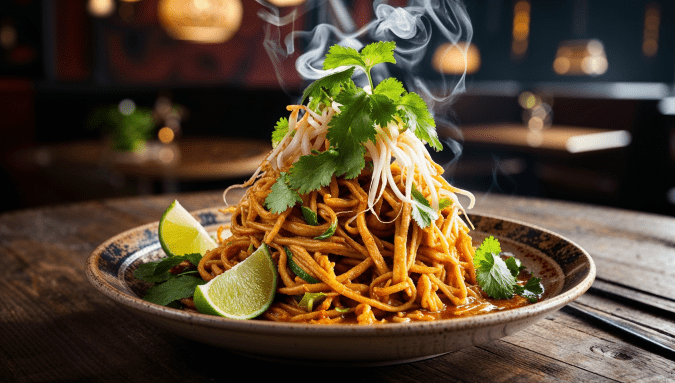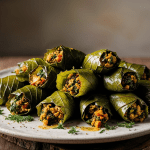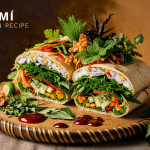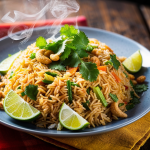This Vegetarian Pad Thai recipe is a vibrant and satisfying dish that can be prepared quickly, making it perfect for a weeknight dinner. Here’s how to make it:
Ingredients
For the Pad Thai:
- 8 oz rice noodles (preferably Pad Thai noodles)
- 14 oz extra firm tofu, pressed and cut into cubes
- 3 tablespoons oil (vegetable or peanut oil)
- 1 tablespoon minced garlic
- 1 small red bell pepper, sliced
- 1 small yellow bell pepper, sliced
- 2 large eggs, whisked (optional for vegan version)
- 3 cups bean sprouts
- ½ cup roasted peanuts, coarsely chopped
- ½ cup fresh cilantro, chopped
- Lime wedges for serving
For the Sauce:
- 3 tablespoons soy sauce or tamari (for gluten-free)
- ¼ cup light brown sugar, packed
- 2 tablespoons tamarind paste
- 2 tablespoons chili garlic sauce or Sriracha (adjust to taste)
Instructions
- Prep the Noodles:
- Soak the rice noodles in hot water for about 10 minutes or according to package instructions until softened. Drain and set aside.
- Make the Sauce:
- In a small saucepan over low-medium heat, combine soy sauce, brown sugar, tamarind paste, and chili garlic sauce. Cook until the sugar dissolves and the sauce thickens slightly. Set aside.
- Cook the Tofu:
- Heat 1 tablespoon of oil in a large wok or skillet over medium-high heat. Add the cubed tofu and fry until golden brown on all sides. Remove from the pan and set aside.
- Stir-Fry the Vegetables:
- In the same pan, add another tablespoon of oil. Sauté the minced garlic for about 30 seconds until fragrant.
- Add the sliced bell peppers and cook for about 2 minutes until they start to soften.
- Combine Ingredients:
- Push the vegetables to one side of the pan and add the remaining oil in the middle. If using eggs, pour in the whisked eggs and scramble them until just set.
- Add the soaked noodles, cooked tofu, and prepared sauce to the pan. Toss everything together using tongs until well combined and heated through.
- Finish with Garnishes:
- Stir in the bean sprouts and remove from heat. Serve immediately topped with chopped peanuts, cilantro, and lime wedges.
Tips
- For a completely vegan version, omit the eggs or substitute with scrambled tofu or vegan egg alternatives.
- Feel free to customize your Pad Thai by adding other vegetables like zucchini, carrots, or broccoli based on your preference.
- Adjust the spiciness of your sauce by varying the amount of chili garlic sauce or Sriracha used.
Enjoy this delicious and easy-to-make Vegetarian Pad Thai!
Creative Variations for Vegetarian Pad Thai
- Noodle Alternatives: Use spiralized vegetables like zucchini or carrots instead of traditional rice noodles for a low-carb version.
- Protein Options: Incorporate different plant-based proteins such as tempeh, chickpeas, or edamame in place of tofu.
- Sauce Variations: Experiment with different sauces by adding peanut butter for creaminess or using a blend of soy sauce and miso for a unique flavor.
- Spice it Up: Add more heat with extra chili garlic sauce or Sriracha, or incorporate fresh chilies for a spicy kick.
- Herb Infusions: Mix in fresh herbs like basil or mint for added freshness and flavor.
Vegan Pad Thai Sauce from Scratch
To create a vegan Pad Thai sauce, combine the following ingredients in a bowl:
- 4 tablespoons low-sodium soy sauce or tamari
- 2 tablespoons tamarind paste
- 2 tablespoons maple syrup or agave syrup
- 1 tablespoon rice vinegar
- 1 teaspoon chili garlic sauce or Sriracha (adjust to taste)
Mix these ingredients until well combined, and adjust the sweetness or spiciness according to your preference.
Best Vegetables for Vegetarian Pad Thai
Ideal vegetables to use in Vegetarian Pad Thai include:
- Bean Sprouts: For crunch and freshness.
- Bell Peppers: Red and yellow varieties add sweetness and color.
- Carrots: Sliced thinly for texture and sweetness.
- Zucchini: Adds moisture and can be spiralized as a noodle substitute.
- Green Onions: For a mild onion flavor and garnish.
- Mushrooms: Shiitake or button mushrooms add umami richness.
Using Gluten-Free Noodles
Yes, you can use gluten-free noodles in this recipe. Look for rice noodles labeled gluten-free, or you can substitute with other gluten-free options like quinoa noodles or even spiralized vegetables.
Preventing Soggy Noodles
To prevent the noodles from becoming soggy:
- Soak Properly: Soak the rice noodles just until they are pliable but still firm; avoid over-soaking.
- Rinse After Soaking: Rinse the soaked noodles under cold water to stop the cooking process and remove excess starch.
- Stir-Fry Quickly: Add the noodles to the hot pan quickly after soaking, and stir-fry on high heat to keep them firm.
- Add Sauce Sparingly: Pour the sauce gradually while tossing the noodles to ensure they are evenly coated without soaking them too much.





